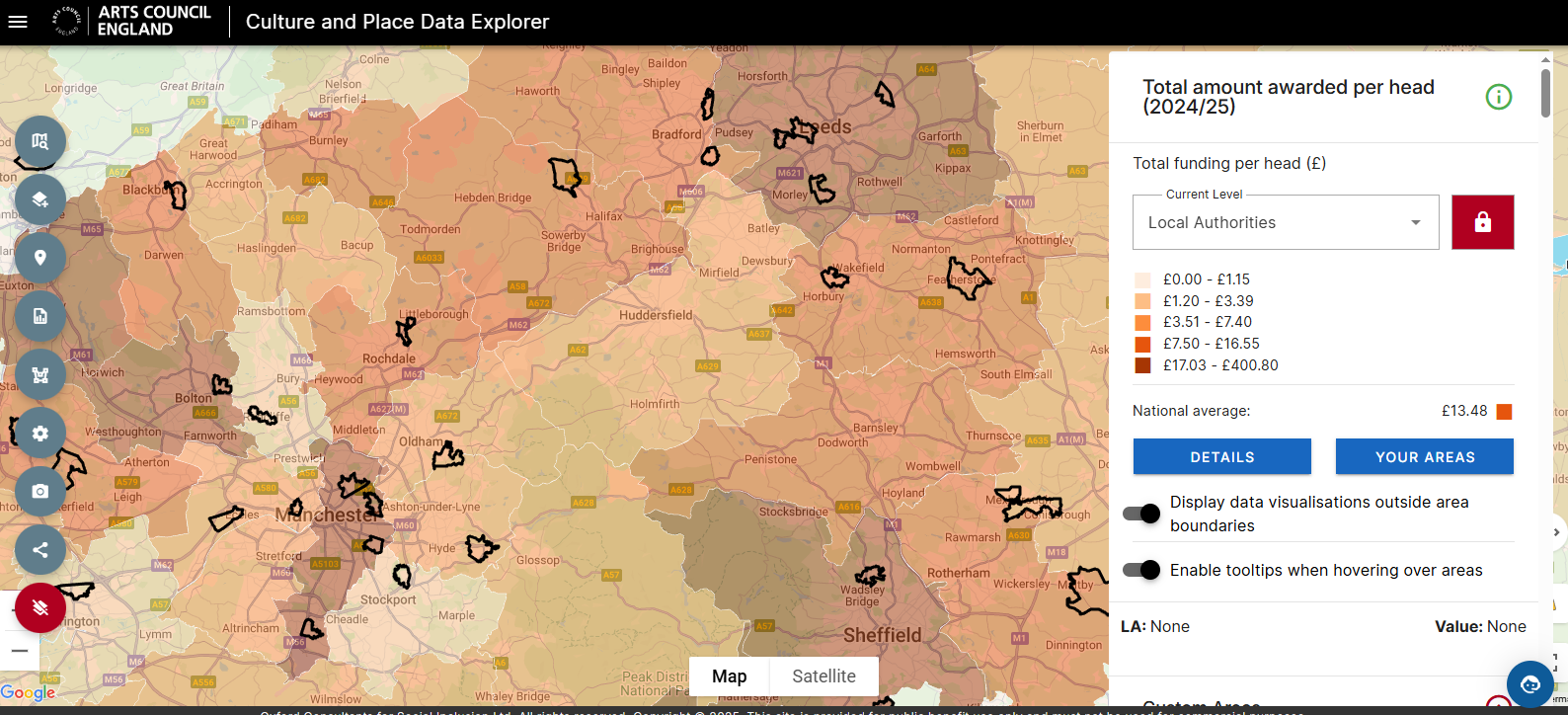
When Arts Council England launched its Let’s Create strategy, it brought a renewed focus on place and a mission to deliver more arts and culture on people’s doorsteps. This ambition required a richer understanding of how arts and cultural investment reaches communities at a hyper-local level.
Although Arts Council England already held vast amounts of investment data, the tools available could only present local authority level summaries. Teams across the organisation were producing their own spreadsheets, dashboards and one-off analyses to answer local questions. These workarounds were time-consuming, inconsistent and difficult to maintain.
Externally, they also wanted a tool for partners; local authorities, creative organisations and their national portfolio organisations to support their place-based working.
Arts Council England needed a single, intuitive platform bringing together investment data, social context and meaningful local geographies with no barriers to access for the sector.
Arts Council England partnered with OCSI and Five10Twelve to build what would become the Culture and Place Data Explorer (CPDEx), using Local Insight as the foundation. The platform offered trusted data, intuitive design and flexibility to customise to their needs..
Development followed a collaborative, test-and-learn approach. Early prototypes were shaped by insights from Arts Council England staff, cultural organisations and local authorities. This iterative work guided decisions about data selection, report design and the inclusion of custom geographies, ensuring the tool met the needs of both experienced analysts and non-technical users.
“It felt like a real partnership — the flexibility and responsiveness made everything doable.”
Jason Jones-Hall, Director of Development, Five10Twelve
Launched as a free, open-access platform, the CPDEx allows users to understand cultural investment alongside a wide range of socio-economic indicators, including population data, deprivation measures, age profiles and more. This provides a far richer foundation for understanding how culture connects with place.
The tool also includes a series of tailored geographies, reflecting the communities Arts Council England and their partners work with. Users can explore data by constituency for local advocacy, compare combined authorities, or look across Arts Council England priority places. At the same time, familiar geographies such as LSOAs and local authorities offer multiple ways to view the same story.
Complementing the mapping tools are two styles of report: a concise summary for quick reference and a detailed version for deeper analysis and time-series trends, including cultural investment data.
“The CPDEx makes cultural data visible and aligns it with wider social and economic information.”
Jason Jones-Hall, Five10Twelve

Map shows Arts Council England funding data overlaid with service location data for dance related projects.
The CPDEx has already begun shaping meaningful decision-making and engagement across the cultural landscape. Early users are using it to understand local needs, articulate investment and support the development of cultural strategy.
Local authorities are using the CPDEx as a foundation for developing cultural strategies. One council shared how the tool helped them spot gaps in local provision that were not visible in their existing datasets. The CPDEx provided a more comprehensive picture of cultural activity, prompting the team to carry out further public consultation to understand those gaps, insight they say they “wouldn’t have uncovered” otherwise.
Arts Council England area teams can now use the Explorer to brief newly elected MPs or local government leaders. With a few clicks, teams can create tailored constituency summaries showing local cultural investment and contextual data. This has become a quick to implement, evidence-based starting point for conversations with parliamentarians.
The CPDEx has also helped Arts Council England challenge common assumptions around regional funding disparities. Teams can use dashboards to quickly illustrate where investment is flowing across England, supporting more evidence-informed discussions with stakeholders and press.
“We can use CPDEx to produce a detailed report on culture in MP constituency areas — something we simply couldn’t do before.”
Joey McGillott, Product Manager, Arts Council England
The CPDEx is also supporting a cultural infrastructure mapping project in Kent. Using the service data (point-location data that can be viewed on a map) that is available in the platform, the team is able to get a head start in mapping cultural assets, while integrating the information with their own existing GIS and planning systems. What was once a long, drawn out process and often required extensive use of external consultants is now much quicker and smoother – minimising cost and freeing up time to spend on the analysis that matters most.
Internally, the CPDEx has reduced duplication and improved consistency across Arts Council England. Rather than multiple teams creating their own versions of dashboards and reports, the CPDEx now provides a single source of truth for understanding place. The development of the CPDEx has also prompted improvements and clarification to data governance including programme categorisation, data update schedules and workflow documentation.
“Before the CPDEx, everyone had their own version of the data. Now we have a single source of truth.”
James Evans, Data Governance Manager, Arts Council England
With new combined authorities emerging and governance structures shifting, the CPDEx is becoming a crucial tool for helping Arts Council England navigate a complex and fast-moving policy environment. The flexibility to create any geography as custom areas – regardless of whether it is an existing recognised geography – enables teams to understand how investment aligns with new boundaries and supports better forward planning and clearer communication.
For example, the platform now includes Pride in Place locations, giving users the ability to map cultural assets and infrastructure in and around these neighbourhoods.
Analysis has shown that 31% of Pride in Place neighbourhoods overlap with Arts Council England’s 54 priority places. Within the CPDEx users can view the location of regularly funded National Portfolio organisations and their proximity to the Pride in Place locations to help understand the cultural ecosystem in the context of the Pride in Place strategy.
The Pride in Place strategy identifies culture and heritage as potential areas for neighbourhood-level investment to support growth and social cohesion. As neighbourhood boards begin to form, Arts Council England is exploring how best to engage with them, continuing to work through area teams to champion cultural and creative activity that supports the strategy’s aims.

Map shows Arts Council England funding data per head of the population for 2024/25 overlaid with Pride in Place Phase 2 boundaries.
Over the next phase, Arts Council England aims to embed the CPDEx more deeply into everyday practice, both internally and across the cultural sector. Plans include promoting the platform more widely, expanding the range of data available and exploring partnerships to bring in complementary datasets, such as heritage or audience participation.
The CPDEx has already demonstrated its value as a clear, intuitive tool that helps users understand cultural investment alongside context about local communities. With this strong foundation, it is well positioned to become the sector’s essential starting point for place-based cultural insight.
Explore the Culture and Place Data Explorer for yourself.
If you would like to find out how Local Insight can support your organisation with understanding and using place-based data, book a demo with our team.
The 2025 Index of Multiple Deprivation (IMD) provides an updated view of…
More
The English Indices of Deprivation 2025 (IoD 2025) have now been published…
More
The English Indices of Deprivation 2025 (IoD 2025) have now been published…
More